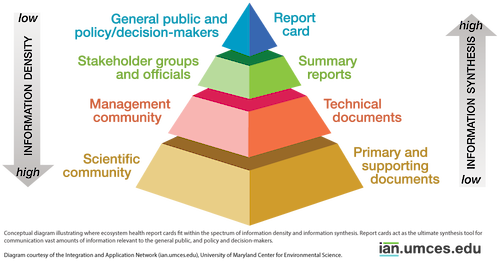Add/Edit story
Add relation/synonym (+)
Add Backgound layer/dimension (+)
The purpose of this site is to map relationships of finite and infinite tasks within a global purpose. Not for a promise of accuracy; but as a tool for decision making in a infinite global world.
Inspiration offsets/foundations include; Earth as a home (Hard+Soft Data), Sustainable Development Goals (Global/Holistic Theory), Permaculture (Tangible base for a “Home”), Open Source Software and Hardware (Idea of free knowledge / sharing; {[one-to-many], [many-to-one], [many-to-many]} / Global-Return-Sharing economy).
It is possible for individual Humans (an Entity); to obtain a variable density of Holistic Sense of Planetary Complexity (EvdHSPC) 1, 2, 3, Bend Not Break
Consider the story elements on this site as individual “Report card” level in the Information density spectrum scale. See image below.And external Web Links as sources for a higher Information density level.
 Ecosystem report cards act as the ultimate synthesis tool for communicating vast amounts of information relevant to the general public and policy decision-makers. This pyramid shows where report cards fit within the spectrum of information density and information synthesis.
Ecosystem report cards act as the ultimate synthesis tool for communicating vast amounts of information relevant to the general public and policy decision-makers. This pyramid shows where report cards fit within the spectrum of information density and information synthesis.
Example of a Summary Report:
The Role of Critical World Energy Outlook Special Report Minerals in Clean Energy Transitions (pdf) First ever IEA Critical Minerals and Clean Energy Summit to take place on 28 September 2023.Example of a Primary and Supporting document:
The Role of Critical World Energy Outlook Special Report Minerals in Clean Energy Transitions (pdf) One of many sources of scientific data sources; Supporting some key issues with the SDG workflow.
The SHORT VERSION:
Use this site as a perspective of a local story; by a specific human or limited group of humans.
It may be partially misleading, depending your own understanding of the semantics meaning or context logic, but could be an reasonable argument and logical from the authors perspective: Therein opens for a co-learning process to clarify the arguments context.
Background for this description: Video: The Culture Map, Book: The Culture Map.
The LESS-SHORT VERSION:
Introduction;
The goal;
This site aims to base the 17 Sustainable Development Goals communication through one of the oldest humans leaning strategies: Storytelling. See (Approximate) History of Storytelling and Worldbuilding as a design practice.
The problem;
The
challenge of communicating an infinite and all-time
changing description is a an practical impossible task.
As
each human have a information learning limit, individual learning
approaches and uneven access to knowledge, in combination with
changing facts references and target .
Communication of infinite geological and times spatial context topics like “Eco-friendly”, “Sustainable” or the 17 Sustainable Development Goals; requires both description of past facts that are approximate, present facts that also is based on approximate assumptions and future reference point of intended goal/path.
To form an finite argument as “ Is my product sustainable?, or how relatively sustainable is it? ”; in a infinite geological and time spatial world-context though any argument model, will always output at least 1 approximate finite and 1 approximate infinite answer.
The finite answer could be; “Yes; my product is sustainable, as the product is an organic apple grown from a tree in my own backyard.”.
The infinite answer could be; “No; my product is not sustainable, if it is shipped across the globe; as the transport depends on pastime innovation of present transportation machines and communication technology for global trust exchange of value as Money or a Legal agreement etc.; considering the pastime energy usage for that innovation, and the present energy usage for transportation.” thereby adding embodied pollution expense in a geological and time spatial perspective to the apple.
Web link: (Approximate) Definition of Knowledge Skills to consider for working with SDGs in todays world ( Value Proposition Design )